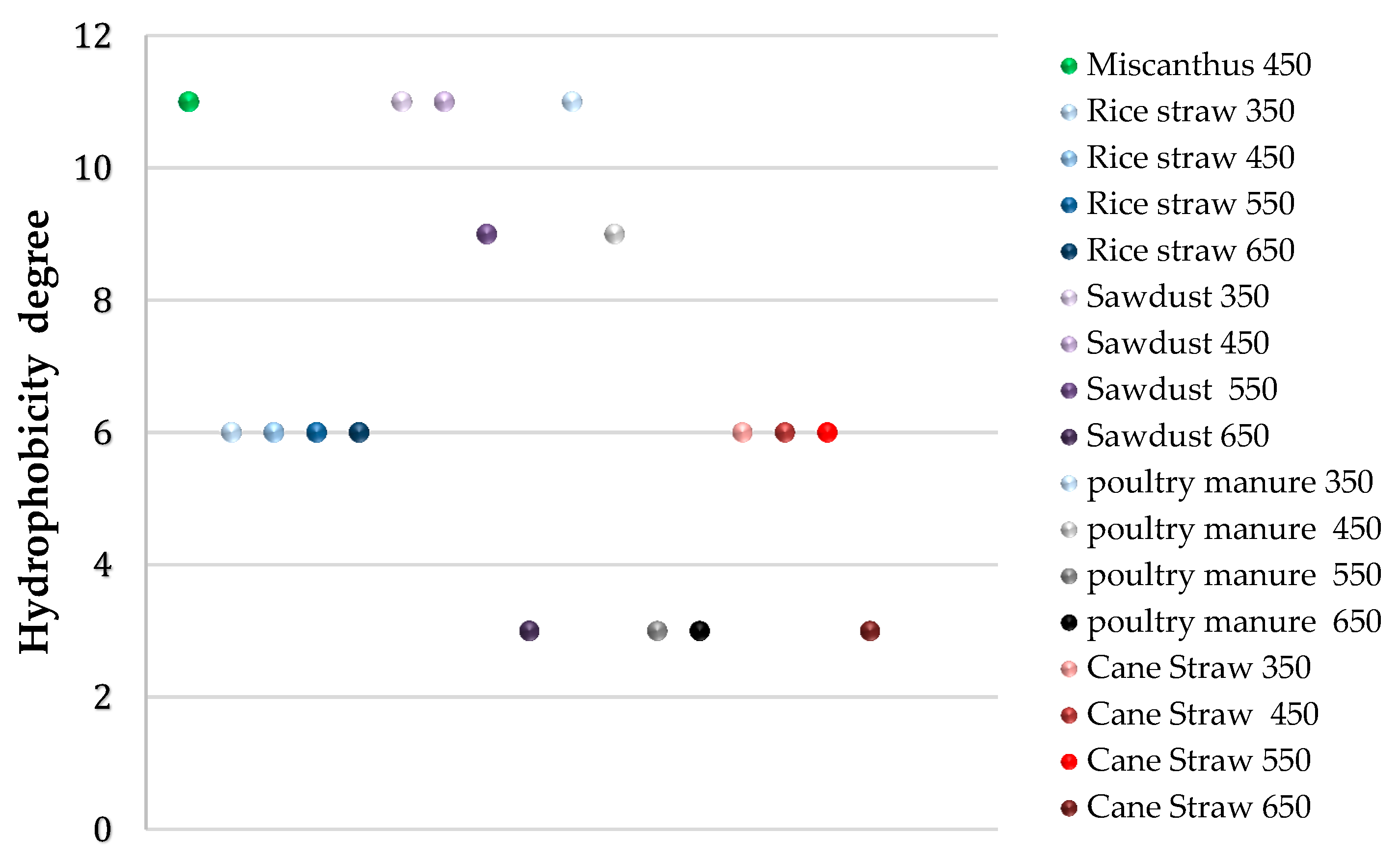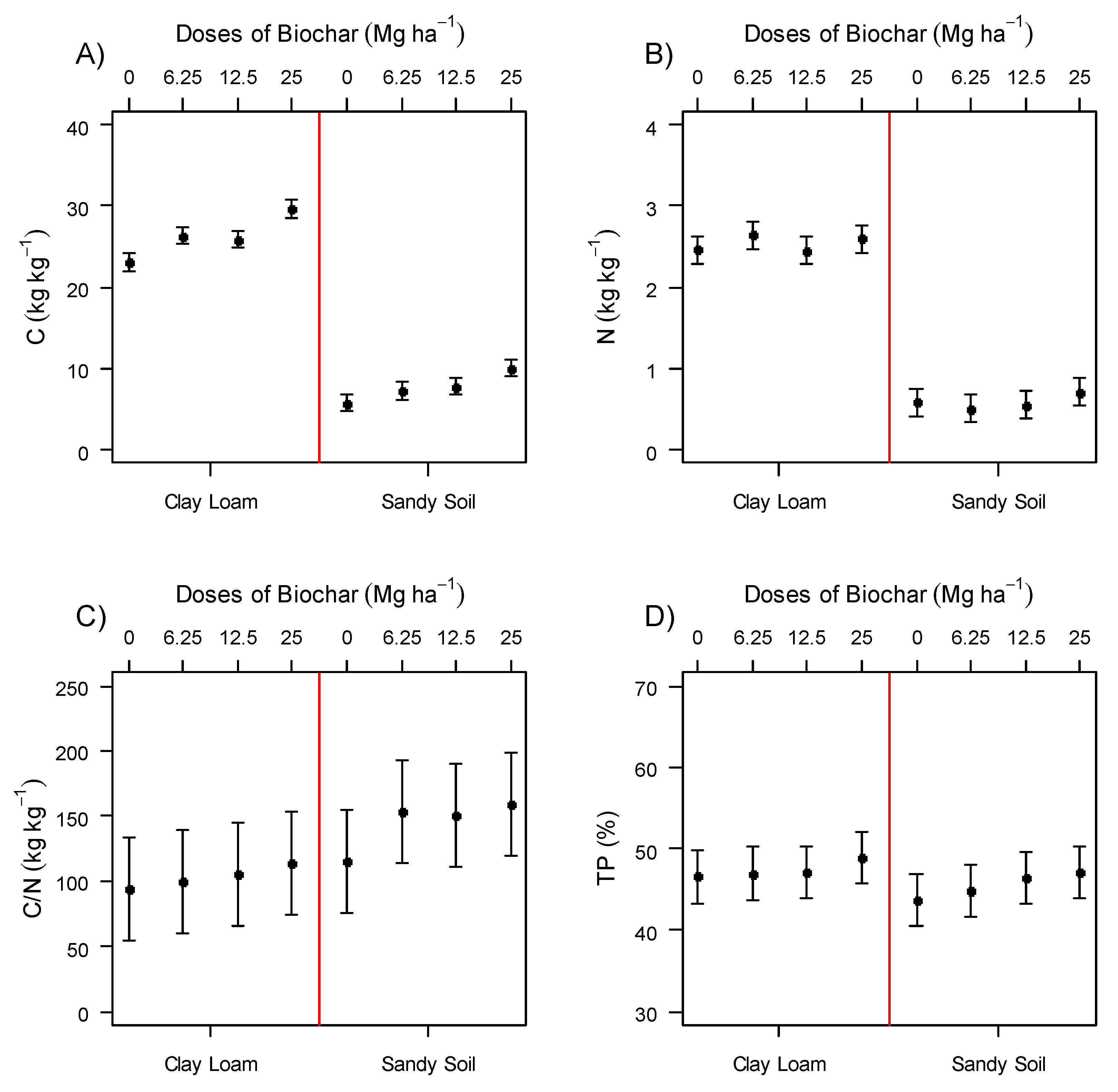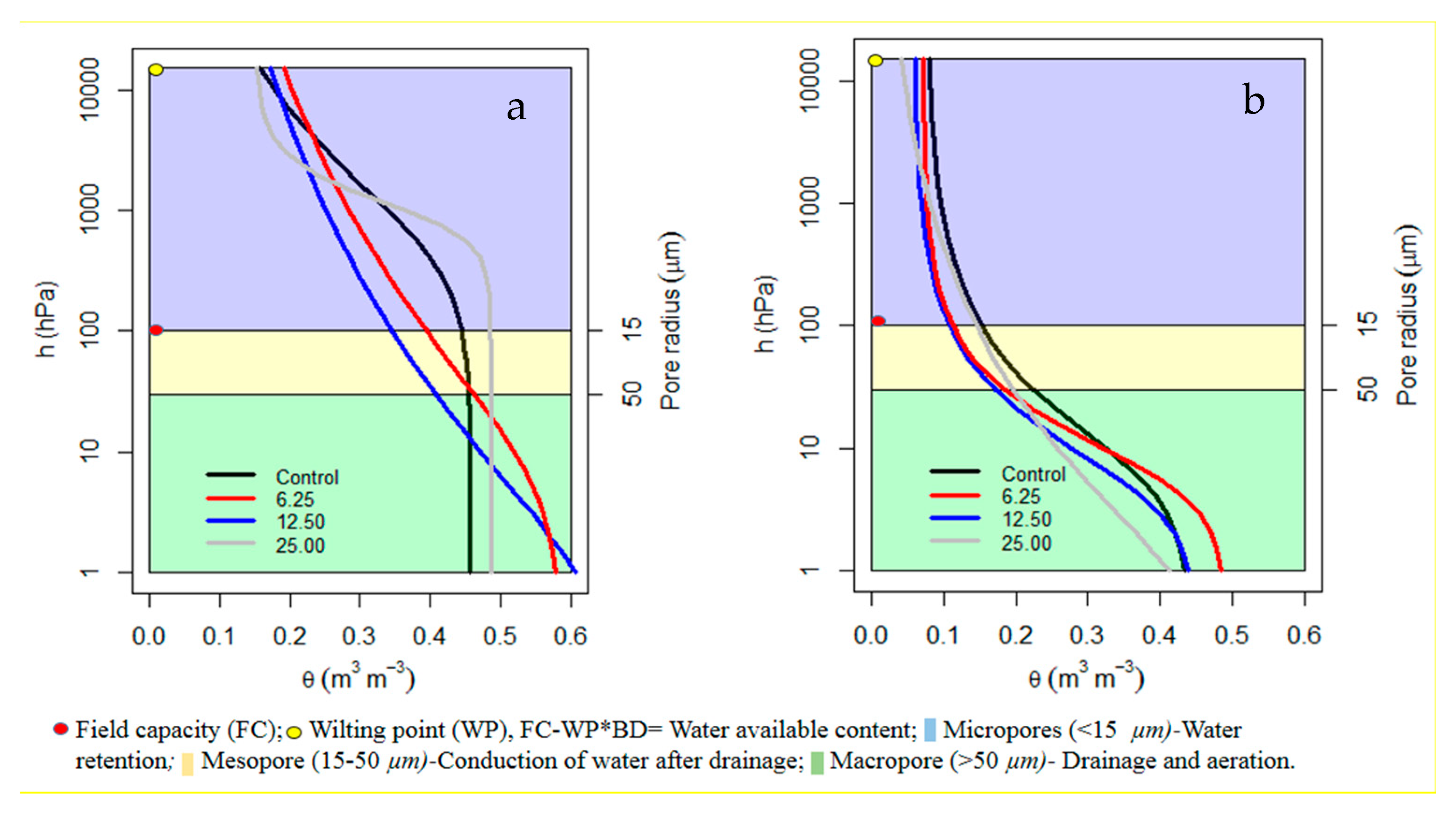Chemical, Physical, and Hydraulic Properties as Affected by One Year of Miscanthus Biochar Interaction with Sandy and Loamy Tropical Soils
Abstract
:1. Introduction
2. Material and Methods
2.1. Biochar Preparation
2.2. Experimental Setup
2.3. Sample Preparation, Incubation, and Sampling
2.4. Biochar and Soil Analysis
2.4.1. Biochar Analysis
2.4.2. Fourier Transform-Infrared Spectroscopy (FTIR)
2.4.3. Hydrophobicity
2.4.4. Soil Analyses
2.5. Physical Analysis
2.5.1. Bulk Density and Particle Density
2.5.2. Soil Texture
2.5.3. Porosity
2.5.4. Water Retention Curve
2.6. Data Analyses
3. Results
3.1. Soil and Biochar Characterization
3.2. Effect on Soil Chemical Properties
3.2.1. Total Carbon
3.2.2. Total Nitrogen
3.2.3. C:N Ratio
3.3. Effect on Soil Physical Properties
3.3.1. Porosity
3.3.2. Bulk Density
3.3.3. Texture
3.4. Effect on Soil Hydraulic Properties
3.4.1. Water Retention Curve
3.4.2. Plant-Available Water Content
3.4.3. Effect of Biochar Doses on Pore Size Distribution and Its Relation with the Water Retention Curve
4. Discussion
4.1. Biochar Effects on Soil Nutrient Storage Capacity
4.1.1. Total Carbon
4.1.2. Nitrogen
4.1.3. C:N Ratio
4.2. Biochar Effects on Soil Physical Properties
4.2.1. Total Porosity
4.2.2. Bulk Density
4.2.3. Texture
4.3. Biochar Effects on Soil Hydraulic Properties
4.3.1. Water Holding Capacity
4.3.2. Relation between Water and Pore Size Distribution
4.3.3. Plant-Available Water Content
4.3.4. Implications for Farmers in Brazil
5. Conclusions
Author Contributions
Funding
Acknowledgments
Conflicts of Interest
References
- Glaser, B.; Haumaier, L.; Guggenberger, G.; Zech, W. The “Terra Preta” phenomenon: A model for sustainable agriculture in the humid tropics. Naturwissenschaften 2001, 88, 37–41. [Google Scholar] [CrossRef] [PubMed]
- Glaser, B.; Lehmann, J.; Zech, W. Ameliorating physical and chemical properties of highly weathered soils in the tropics with charcoal—A review. Biol. Fertil. Soils 2002, 35, 219–230. [Google Scholar] [CrossRef]
- Ajayi, A.E.; Horn, R. Biochar-induced changes in soil resilience: Effects of soil texture and biochar dosage. Pedosphere 2017, 27, 236–247. [Google Scholar] [CrossRef]
- Glaser, B.; Haumaier, L.; Guggenberger, G.; Zech, W. Black carbon in soils: The use of benzenecarboxylic acids as specific markers. Org. Geochem. 1998, 29, 811–819. [Google Scholar] [CrossRef]
- Glaser, B.; Balashov, E.; Haumaier, L.; Guggenberger, G.; Zech, W. Black carbon in density fractions of anthropogenic soils of the Brazilian Amazon region. Org. Geochem. 2000, 31, 669–678. [Google Scholar] [CrossRef]
- Liu, J.; Schulz, H.; Brandl, S.; Miehtke, H.; Huwe, B.; Glaser, B. Short-term effect of biochar and compost on soil fertility and water status of a Dystric Cambisol in NE Germany under field conditions. J. Plant Nutr. Soil Sci. 2012, 175, 698–707. [Google Scholar] [CrossRef]
- Omondi, M.O.; Xia, X.; Nahayo, A.; Liu, X.; Korai, P.K.; Pan, G. Quantification of biochar effects on soil hydrological properties using meta-analysis of literature data. Geoderma 2016, 274, 28–34. [Google Scholar] [CrossRef]
- Downie, A.; Crosky, A.; Munroe, P. Physical properties of biochar. In Biochar for Environmental Management: Science and Technology; Lehmann, J., Joseph, S., Eds.; Earthscan: London, UK, 2009; pp. 13–32. [Google Scholar]
- Cheng, C.H.; Lehmann, J.; Thies, J.E.; Burton, S.D.; Engelhard, M.H. Oxidation of black carbon by biotic and abiotic processes. Org. Geochem. 2006, 37, 1477–1488. [Google Scholar] [CrossRef]
- Piccolo, A.; Mbagwu, J.S.C. Effects of different organic waste amendments on soil microaggregates stability and molecular sizes of humic substances. Plant Soil 1990, 123, 27–37. [Google Scholar] [CrossRef]
- Lehmann, J.; Gaunt, J.; Rondon, M. Bio-char sequestration in terrestrial ecosystems. A review. Mitig. Adapt. Strateg. Glob. Chang. 2006, 11, 403–427. [Google Scholar] [CrossRef]
- Blanco-Canqui, H. Biochar and soil physical properties. Soil Sci. Soc. Am. J. 2017, 84, 687. [Google Scholar] [CrossRef]
- Alghamdi, A.G. Biochar as a potential soil additive for improving soil physical properties—A review. Arab. J. Geosci 2018, 11, 776. [Google Scholar] [CrossRef]
- Laird, D.A.; Fleming, P.; Davis, D.D.; Horton, R.; Wang, B.; Karlen, D.L. Impact of biochar amendments on the quality of a typical Midwestern agricultural soil. Geoderma 2010, 158, 443–449. [Google Scholar] [CrossRef] [Green Version]
- Zhang, A.; Bian, R.; Pan, G.; Cui, L.; Hussain, Q.; Li, L.; Zheng, J.; Zheng, J.; Zhang, X.; Han, X.; et al. Effects of biochar amendment on soil quality, crop yield and greenhouse gas emission in a Chinese rice paddy: A field study of 2 consecutive rice growing cycles. F. Crop. Res. 2012, 127, 153–160. [Google Scholar] [CrossRef]
- Novak, J.M.; Busscher, W.J.; Watts, D.W.; Amonette, J.E.; Ippolito, J.A.; Lima, I.M.; Gaskin, J.; Das, K.C.; Steiner, C.; Ahmedna, M.; et al. Biochars impact on soil-moisture storage in an ultisol and two aridisols. Soil Sci. 2012, 177, 310–320. [Google Scholar] [CrossRef]
- International Biochar Initiative. Standardized Product Definition and Product Testing Guidelines for Biochar That is Used in Soil, International Biochar Initiative. 2015. Available online: http://www.biochar-international.org/sites/defaut/files/IBI_Biochar_Standards_V1.1.pdf (accessed on 5 December 2018).
- Chan, K.Y.; Bowman, A.; Oates, A. Oxidizable organic carbon fractions and soil quality changes in an oxic paleustaff under different pasture leys. Soil Sci. 2001, 166, 61–67. [Google Scholar] [CrossRef]
- American Society for Testing and Materials. Standard Test Method for the Analysis of Wood Charcoal (ASTM D1762-84); ASTM International: West Conshohocken, PA, USA, 2007. [Google Scholar]
- American Society for Testing and Materials. Test Method for Ash in the Analysis Sample of Coal and Coke from Coal; ASTM International: West Conshohocken, PA, USA, 2007. [Google Scholar]
- Cerato, A.B.; Lutenegger, A.J. Determination of surface area of fine-grained soils by the ethylene glycol monoethyl ether (EGME) method. Geotech. Test. J. 2002, 25, 315–321. [Google Scholar] [CrossRef]
- Watson, C.L.; Letey, J. Indices for characterizing soil-water repellency based upon contact angle-surface tension relationships. Soil Sci. Soc. Am. J. 1970, 34, 841–844. [Google Scholar] [CrossRef]
- Letey, J.; Carrillo, M.L.K.; Pang, X.P. Approaches to characterize the degree of water repellency. J. Hydrol. 2000, 231–232, 61–65. [Google Scholar] [CrossRef]
- Van Raij, B.; Andrade, J.C.; Cantarella, H.; Quaggio, J.A. Análise Química para Avaliação da Fertilidade de Solos Tropicais; Campinas Instituto Agronômico: Campinas, Brazil, 2001; 285p. [Google Scholar]
- LECO Corporation CN-2000. Available online: http://www.labwrench.com/?equipment.view/equipmentNo/14102/LECO-Corporation/CN-2000/ (accessed on 3 December 2018).
- Blake, G.R.; Hartge, K.H. Bulk density. In Methods of Soil Analysis, Part 1—Physical and Mineralogical Methods, 2nd ed.; Klute, A., Ed.; Agronomy Monograph 9; American Society of Agronomy—Soil Science Society of America: Madison, WI, USA, 1986; pp. 363–382. [Google Scholar]
- Gee, G.W.; Bauder, J.W. Particle-size analysis. In Methods of Soil Analysis, Part 1—Physical and Mineralogical Methods, 2nd ed.; Klute, A., Ed.; Agronomy Series 9; American Society of Agronomy—Soil Science Society of America: Madison, WI, USA, 2002; pp. 383–411. [Google Scholar]
- Flint, L.E.; Flint, A.L. Porosity. In Methods in Soil Analysis, Part 4—Physical Methods; Dane, J.H., Topp, G.C., Eds.; Soil Science Society of America: Madison, WI, USA, 2002. [Google Scholar]
- Koorevaar, P.; Menelik, G.; Kirksen, C. Elements of Soil Physics: Developments in Soil Science; Elsevier: Amsterdam, The Netherlands, 1983; Volume 13, 228p. [Google Scholar]
- Klute, A.; Klute, A.; Dirksen, C. Hydraulic Conductivity and Diffusivity: Laboratory Methods 9; ASA: Madison, WI, USA, 1986. [Google Scholar]
- Van-Genuchten, M.T. A Closed-form equation for predicting the hydraulic conductivity of unsaturated Soils. Soil. Sci. Soc. Am. 1980, 44, 892–898. [Google Scholar] [CrossRef]
- RStudio Team. RStudio: Integrated Development for R; RStudio, Inc.: Boston, MA, USA, 2015; Available online: http://www.rstudio.com/ (accessed on 2 December 2018).
- Conz, R.F.; Abbruzzini, T.F.; Andrade, C.A.; Milori, D.M.B.P.; Cerri, C.E.P. Effect of pyrolysis temperature and feedstock type on agricultural properties and stability of biochars. Agricult. Sci. 2017, 8, 914–933. [Google Scholar]
- Hammes, K.; Torn, M.S.; Lapenas, A.G.; Schmidt, M.W.I. Centennial black carbon turnover observed in a Russian steppe soil. Biogeosci. 2008, 5, 1339–1350. [Google Scholar] [CrossRef] [Green Version]
- Weber, J.; Karczewska, A.; Drozd, J.; Licznar, M.; Licznar, S.; Jamroz, E.; Kocowicz, A. Agricultural and ecological aspects of a sandy soil as affected by the application of municipal solid waste composts. Soil Biol. Biochem. 2007, 39, 1294–1302. [Google Scholar] [CrossRef]
- Zimmerman, J.K.; Pulliam, W.M.; Lodge, D.J.; Quiñones-Orfila, V.; Fetcher, N.; Guzmán-Grajales, S. Nitrogen immobilization by decomposing woody debris and the recovery of tropical wet forest from hurricane damage. Oikos 1995, 72, 314. [Google Scholar] [CrossRef]
- Atkinson, C.J.; Fitzgerald, J.D.; Hipps, N.A. Potential mechanisms for achieving agricultural benefits from biochar application to temperate soils: A review. Plant Soil 2010, 337, 1–18. [Google Scholar] [CrossRef]
- Arvidsson, J. Nutrient uptake and growth of barley as affected by soil compaction. Plant Soil 1999, 208, 9–19. [Google Scholar] [CrossRef]
- Usowicz, B.; Lipiec, J.; Łukowski, M.; Marczewski, W.; Usowicz, J. The effect of biochar application on thermal properties and albedo of loess soil under grassland and fallow. Soil Tillage Res. 2016, 164, 45–51. [Google Scholar] [CrossRef]
- Bruun, E.W.; Petersen, C.T.; Hansen, E.; Holm, J.K.; Hauggaard-Nielsen, H. Biochar amendment to coarse sandy subsoil improves root growth and increases water retention. Soil Use Manag. 2014, 30, 109–118. [Google Scholar] [CrossRef]
- Devereux, R.C.; Sturrock, C.J.; Mooney, S.J. The effects of biochar on soil physical properties and winter wheat growth. Earth Environ. Sci. Trans. R. Soc. Edinburgh 2013, 103, 13–18. [Google Scholar] [CrossRef]
- Githinji, L. Effect of biochar application rate on soil physical and hydraulic properties of a sandy loam. Arch. Agron. Soil Sci. 2014, 60, 457–470. [Google Scholar] [CrossRef]
- Simpson, T.L.; Volcani, B.E. Silicon and Siliceous Structures in Biological Systems; Springer: New York, NY, USA, 1981. [Google Scholar]
- Pandis, C.; Spanoudaki, A.; Kyritsis, A.; Pissis, P.; Hernández, J.C.R.; Gõmez Ribelles, J.L.; Monleõn Pradas, M. Water sorption characteristics of poly(2-hydroxyethyl acrylate)/silica nanocomposite hydrogels. J. Polym. Sci. Part B Polym. Phys. 2011, 49, 657–668. [Google Scholar] [CrossRef]
- Kinney, T.J.; Masiello, C.A.; Dugan, B.; Hockaday, W.C.; Dean, M.R.; Zygourakis, K.; Barnes, R.T. Hydrologic properties of biochars produced at different temperatures. Biomass Bioenergy 2012, 41, 34–43. [Google Scholar] [CrossRef]
- Ojeda, G.; Mattana, S.; Àvila, A.; Alcañiz, J.M.; Volkmann, M.; Bachmann, J. Are soil-water functions affected by biochar application? Geoderma 2015, 249–250, 1–11. [Google Scholar] [CrossRef]
- Mukherjee, A.; Lal, R. Biochar impacts on soil physical properties and greenhouse gas emissions. Agronomy 2013, 3, 313–339. [Google Scholar] [CrossRef]
- Jeffery, S.; Verheijen, F.G.A.; van der Velde, M.; Bastos, A.C. A quantitative review of the effects of biochar application to soils on crop productivity using meta-analysis. Agric. Ecosyst. Environ. 2011, 144, 175–187. [Google Scholar] [CrossRef]
- Peake, L.R.; Reid, B.J.; Tang, X. Quantifying the influence of biochar on the physical and hydrological properties of dissimilar soils. Geoderma 2014, 235–236, 182–190. [Google Scholar] [CrossRef]
- Christensen, B.T. Wheat and barley straw decomposition under field conditions: Effect of soil type and plant cover on weight loss, nitrogen and potassium content. Soil Biol. Biochem. 1985, 17, 691–697. [Google Scholar] [CrossRef]
- Andrenelli, M.C.; Maienza, A.; Genesio, L.; Miglietta, F.; Pellegrini, S.; Vaccari, F.P.; Vignozzi, N. Field application of pelletized biochar: Short term effect on the hydrological properties of a silty clay loam soil. Agricult. Water Manag. 2016, 163, 190–196. [Google Scholar] [CrossRef]
- Gaskin, J.W.; Speir, R.A.; Harris, K.R.; Lee, R.D.; Morris, L.M.; Das, K.C. Effect of two types of pyrolysis chars on corn yield, soil nutrient status, and soil C in loamy sand soil of the southeastern United States. In Proceedings of the ASA-CSSA-SSSA International annual Meetings, Madison, WI, USA, 4–18 November 2007. [Google Scholar]
- Salinas, J.; García, I.; Del Moral, F.; Simón, M. Use of marble sludge and biochar to improve soil water retention capacity. Spanish J. Soil Sci. 2018, 8, 121–129. [Google Scholar] [CrossRef]
- Baronti, S.; Vaccari, F.P.; Miglietta, F.; Calzolari, C.; Lugato, E.; Orlandini, S.; Pini, R.; Zulian, C.; Genesio, L. Impact of biochar application on plant water relations in Vitis vinifera (L.). Eur. J. Agron. 2014, 53, 38–44. [Google Scholar] [CrossRef]
- Skin, J.W.; Speir, A.; Morris, L.M.; Ogden, L.; Harris, K.; Lee, D.; Das, K.C. Potential for pyrolysis char to affect soil moisture and nutrient retention status of a loamy sand soil. In Proceedings of the 2007 Georgia Water Resources Conference, Athens, Georgia, 27–29 March 2007. [Google Scholar]
- Liu, Z.; Dugan, B.; Masiello, C.A.; Gonnermann, H.M. Biochar particle size, shape, and porosity act together to influence soil water properties. PLoS ONE 2017, 12, e0179079. [Google Scholar] [CrossRef] [PubMed]
- Major, J.; Rondon, M.; Molina, D.; Riha, S.J.; Lehmann, J. Maize yield and nutrition during 4 years after biochar application to a Colombian savanna oxisol. Plant Soil 2010, 333, 117–128. [Google Scholar] [CrossRef] [Green Version]
- Conte, P.; Hanke, U.M.; Marsala, V.; Cimoò, G.; Alonzo, G.; Glaser, B. Mechanisms of water interaction with pore systems of hydrochar and pyrochar from poplar forestry waste. J. Agric. Food Chem. 2014, 62, 4917–4923. [Google Scholar] [CrossRef]
- Castellini, M.; Giglio, L.; Niedda, M.; Palumbo, A.D.; Ventrella, D. Impact of biochar addition on the physical and hydraulic properties of a clay soil. Soil Tillage Res. 2015, 154, 1–13. [Google Scholar] [CrossRef]
- Brewer, C.E.; Chuang, V.J.; Masiello, C.A.; Gonnermann, H.; Gao, X.; Dugan, B.; Driver, L.E.; Panzacchi, P.; Zygourakis, K.; Davies, C.A. New approaches to measuring biochar density and porosity. Biomass Bioenergy 2014, 66, 176–185. [Google Scholar] [CrossRef]
- Tryon, E.H. Effect of charcoal on certain physical, chemical, and biological properties of forest soils. Ecol. Monogr. 1948, 18, 81–115. [Google Scholar] [CrossRef]







| Property | Biochar | Sandy Soil | Loamy Soil |
|---|---|---|---|
| -----------------------(%)-------------------- | |||
| Sand | 90 | 40.6 | |
| Silt | 2.2 | 27.7 | |
| Clay | 7.8 | 31.7 | |
| pH (H2O) | 5.86 | ||
| pH (CaCl2) | 3.90 | 6.50 | |
| Yield 31 | |||
| Moisture | 3.5 | ||
| Volatile material | 34.6 | ||
| Ash | 6.1 | ||
| Fixed carbon | 57.1 | ||
| Total N | 0.43 | ||
| 13C | −13.41 | ||
| Total C | 66.35 | 0.86 | 1.93 |
| N | 0.43 | 0.06 | 0.17 |
| C/N | 155.4 | 14.3 | 11.4 |
| Labile C (%) | 2.70 | ||
| Stable C (%) | 50.87 | ||
| Lability | 0.05 | ||
| CEC (mmolcdm−3) | 33 | 69 | 138 |
| Specific surface area (m2 g−1) | 371.9 | ||
| Electric conductivity ((µS cm−1) | 605 | ||
| ----------------(mg kg−1)---------------- | |||
| Na | 423 | ||
| P | 1859 | 4 | 28 |
| S | 634 | 5.30 | 9.50 |
| Fe | 1317 | ||
| Mn | 139 | ||
| Cu | 59 | ||
| Mo | 0.66 | ||
| Zn | 138 | ||
| Ni | 7.74 | ||
| ----------------(mmolcdm−3)---------------- | |||
| Al | 5.7 | 0 | |
| H + Al | 62 | 18 | |
| SB | 6.9 | 120 | |
| V (%) | 10 | 87 | |
| m (%) | 45 | 0 | |
| Treatment | Sand | Silt | Clay | Textural Class |
|---|---|---|---|---|
| ------------------------(%)---------------------- | ||||
| Control | 40.6 | 27.7 | 31.7 | Clay Loam |
| Biochar 25 Mg ha−1 | 34.7 | 27.0 | 38.3 | Clay Loam |
| Control | 90 | 2.2 | 7.8 | Sandy |
| Biochar 25 Mg ha−1 | 91 | 5.8 | 3.3 | Sandy |
© 2019 by the authors. Licensee MDPI, Basel, Switzerland. This article is an open access article distributed under the terms and conditions of the Creative Commons Attribution (CC BY) license (http://creativecommons.org/licenses/by/4.0/).
Share and Cite
de Jesus Duarte, S.; Glaser, B.; Paiva de Lima, R.; Pelegrino Cerri, C.E. Chemical, Physical, and Hydraulic Properties as Affected by One Year of Miscanthus Biochar Interaction with Sandy and Loamy Tropical Soils. Soil Syst. 2019, 3, 24. https://doi.org/10.3390/soilsystems3020024
de Jesus Duarte S, Glaser B, Paiva de Lima R, Pelegrino Cerri CE. Chemical, Physical, and Hydraulic Properties as Affected by One Year of Miscanthus Biochar Interaction with Sandy and Loamy Tropical Soils. Soil Systems. 2019; 3(2):24. https://doi.org/10.3390/soilsystems3020024
Chicago/Turabian Stylede Jesus Duarte, Sara, Bruno Glaser, Renato Paiva de Lima, and Carlos Eduardo Pelegrino Cerri. 2019. "Chemical, Physical, and Hydraulic Properties as Affected by One Year of Miscanthus Biochar Interaction with Sandy and Loamy Tropical Soils" Soil Systems 3, no. 2: 24. https://doi.org/10.3390/soilsystems3020024
APA Stylede Jesus Duarte, S., Glaser, B., Paiva de Lima, R., & Pelegrino Cerri, C. E. (2019). Chemical, Physical, and Hydraulic Properties as Affected by One Year of Miscanthus Biochar Interaction with Sandy and Loamy Tropical Soils. Soil Systems, 3(2), 24. https://doi.org/10.3390/soilsystems3020024






